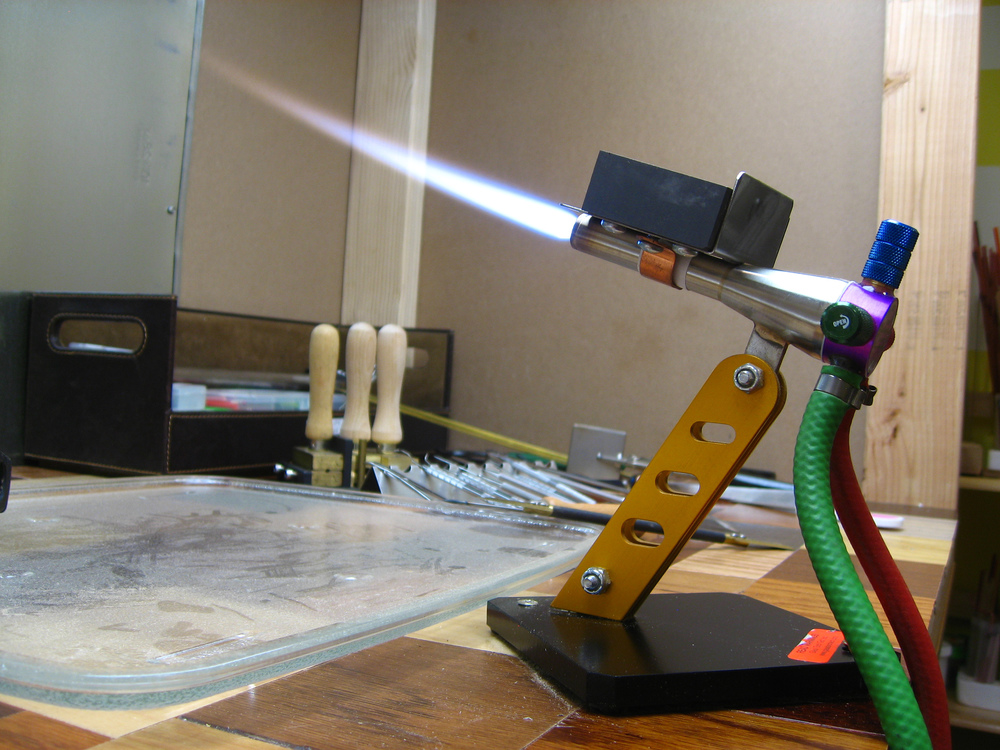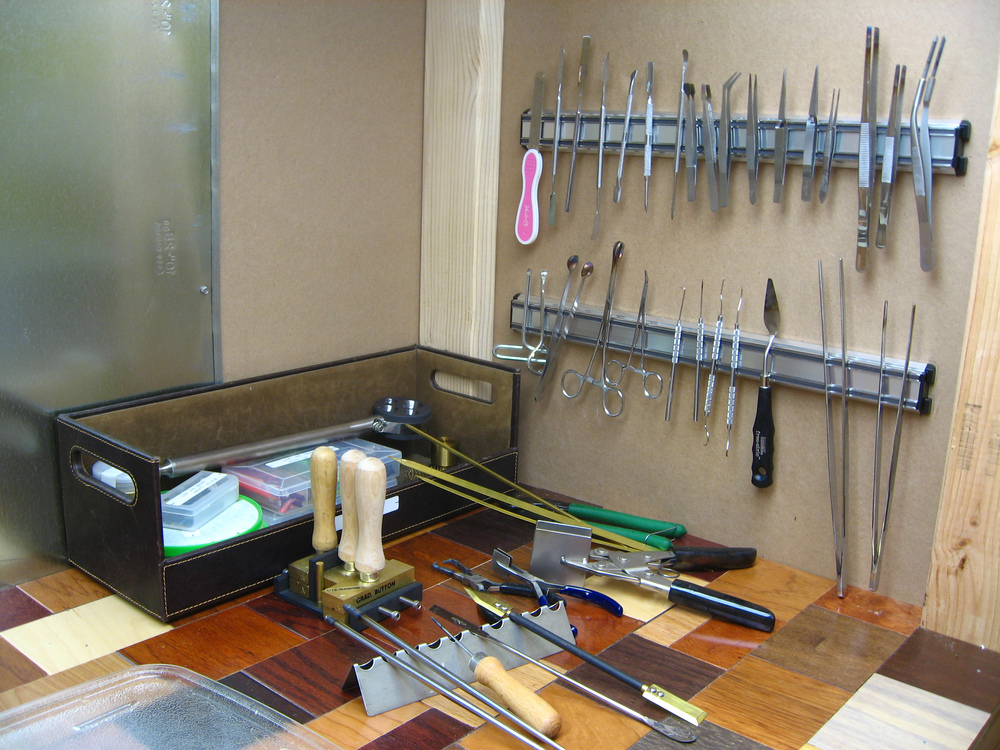I am glad you are interested in the fun art of Lampworking! Before you begin, however, you must understand some very important safety rules.
Safety & Disclaimer
Lampworking is Dangerous
Lampworking involves very hot glass, a very hot torch, and a flammable fuel system usually stored under high pressure. This is a dangerous combination!
DO NOT begin flameworking until you have read and understood all of the safety precautions. You are responsible for your own safety!
First off - Never, Never, Never touch hot glass with your hand! This may be difficult if you come from a background that involves a lot of touching, such as clay sculpting or pottery. But you will learn quickly. Sometimes glass will look obviously molten white hot or red hot, but sometimes it is not obvious that it is hot, so please be aware of where your bead is, and do not touch the bead to any part of your body.
If you are using a Hothead torch with MAPP gas canisters, make sure that your torch is fixed to your work space. It is very important to clamp your torch down so you don't accidentally knock it over and cause a fire hazard. Make sure you have the appropriate hose, clamps, brackets, or stand!
If you are using a torch with propane/oxygen fuel, make sure you have a check valve and flashback arrestor. These are important safety equipment that makes sure that the flame from the torch never goes backwards down the hose to the fuel tank. You can imagine that fire going directly to the fuel tank can result in a large explosion, with damage to property and persons! A check valve keeps the gas flowing in the right direction, so that it can never go back to the tank. Flashback Arrestors
also check the gas movement, but also has a component that can extinguish a possible flame.
If you are using a torch with propane/oxygen, make sure you have working propane and oxygen regulators. I prefer the regulators with a visible pressure gauge. You cannot use old regulators that have been used with any other fuel source. Regulators allow you to control the flow of fuel to your torch.
Always wear protective didymium glasses. My pair is pictured to the left of the flame. It's of the "fit over glasses" variety. Note the purple/blue tint to the lenses. These safety glasses protect your eyes from bright yellow sodium flare and UV light.
Protective Goggles are Necessary - Didymium Glasses
are the best for soft glass work. They have purple tinted safety lenses to block UV and sodium flare from the torch. I also have a pair of
Green ACE IR 3.0 lenses
for boro work, since the didymiums weren't enough for me, and I was straining my eyes doing boro. the
Green ACE IR 3.0
blocks infrared, UV, and sodium flare, and is shade 3.0 darker. These have green tinted lenses. I like them because they block out more, but also make it difficult to see (since everything is darker), so I still use regular didymiums for soda lime glass.
You should also have a Fire Extinguisher
,
smoke detector, and carbon monoxide detector
on hand. Fire is a real risk whenever you are working with open flame! Do not take this lightly.
How to Turn on your Fuel Source
If you are using a Hothead torch with MAPP gas or bottled Propane gas, then it is simple. Simply screw the torch head onto the gas bottle tightly. Always check for leaks around the seal before using. Turn the gas on so there is a slow constant flow, then use a striker or lighter to ignite the flame.
If you are using a torch running propane/oxygen dual mix fuel, then it is more complicated. This is a simple presentation, but if you have questions about your setup, please ask a qualified person before starting. You are responsible for your own safety!
You must remember the acronym POOP - Propane, Oxygen, / Oxygen, Propane!
This means that when turing on your torch (assuming you have all of your regulators and safety devices already attached), you must turn the Propane on first, and light the flame on a propane only setting, then turn on the Oxygen. When you extinguish the torch, you turn off the fuel in the opposite order. Turn off the Oxygen first, then turn off the Propane. Always remember to burn off the gas in the lines as well.
Nonflammable working surface
Your lampworking work space should be covered with a non-flammable material. Usually, sheets of metal are good, since they are durable, non-flammable, and relatively inexpensive. When working, you may have pieces of hot glass melting off or dropping off onto your desk surface. Not only would this burn your wooden desk, but it poses another fire hazard.
You may be wondering about my patchwork wood bench surface in the above photos. Directly in front of my torch, I have covered the wood with a large piece of tempered glass. I haven't had any problems, and the glass surface is very pretty (patchwork wood shows through), and super easy to clean up.
Ventilation
Ventilation is a very complicated setup, and deserves its own post! Read about proper ventilation at my "Lampworking Venilation" post.
Safety Rules Summary:
- Tie all long hair back
- All propane and oxygen tanks must be stored outside and must be fitted with flashback arrestors
- Wear close fitting clothing and closed toe shoes
- Always wear an FFP3 mask when dealing with frit + enamel
- Always work with the extraction system on
- Eye protection must always be worn - in the form of didymium lenses
- Don’t eat and drink in the studio
- Wash your hands and face after working
- Know the location of the fire extinguisher, how it operates & the studio exit routes
- The correct sequence for lighting and extinguishing the torch is Propane - Oxygen - Oxygen - Propane (POOP)
- Propane line = orange – right hand knob
- Oxygen line = clear – left hand knob
- Turn off propane at tank and burn off line before leaving
- Leave Oxygen valve open at end of session




